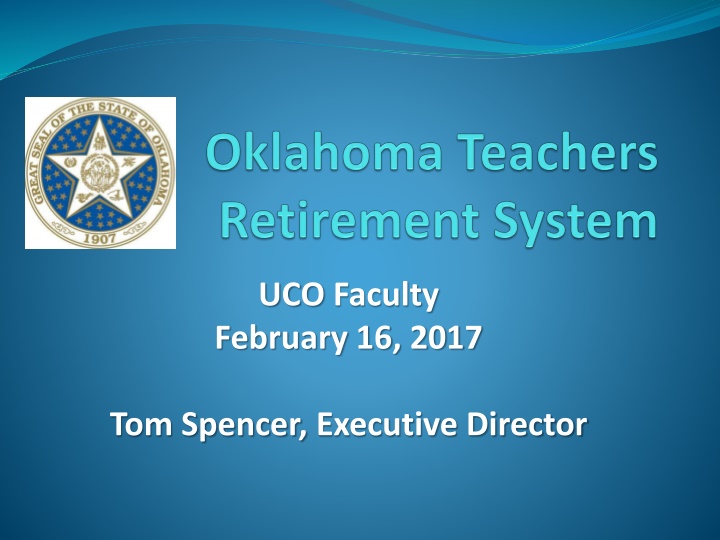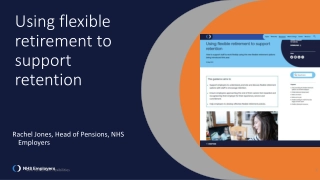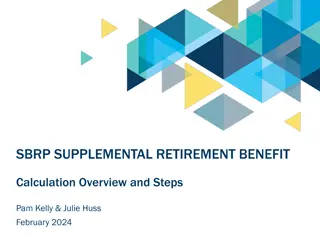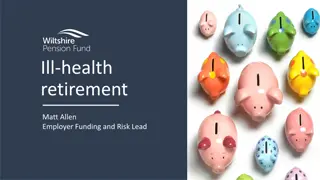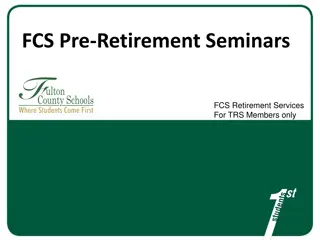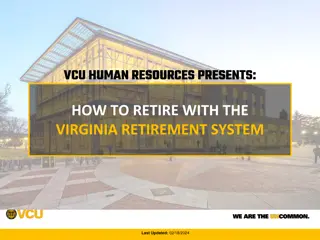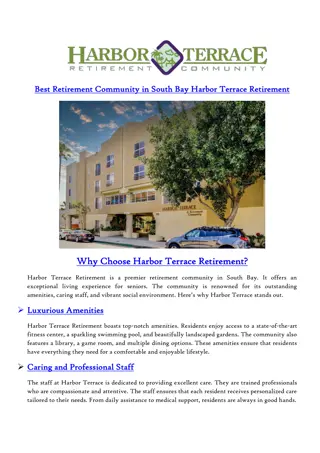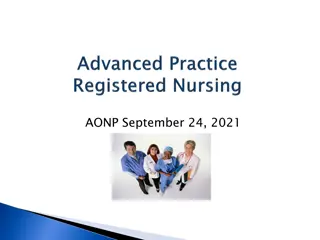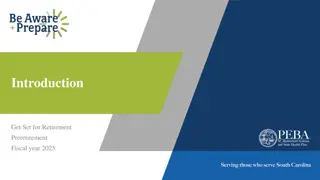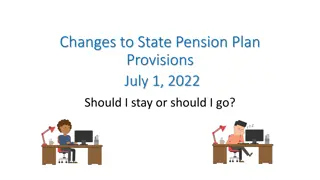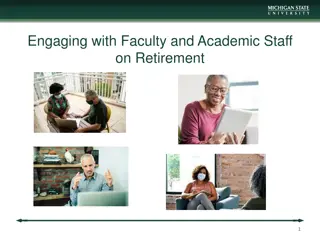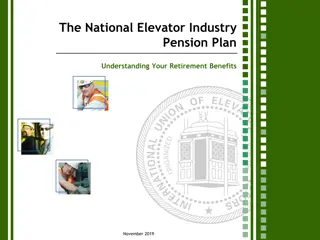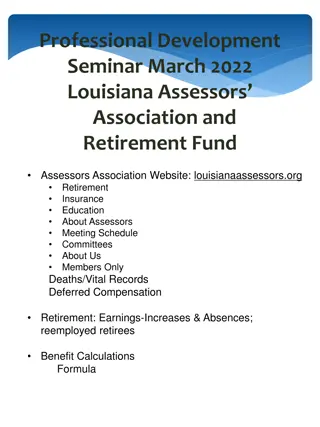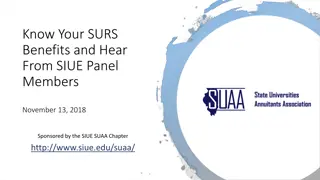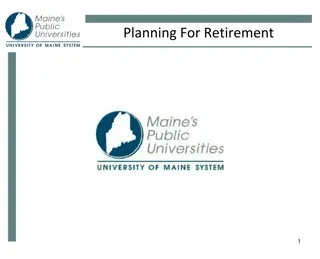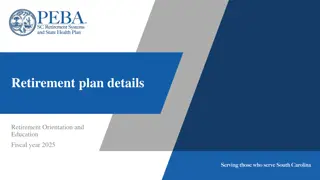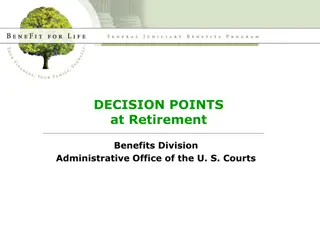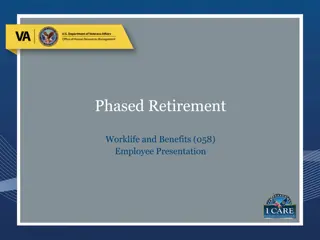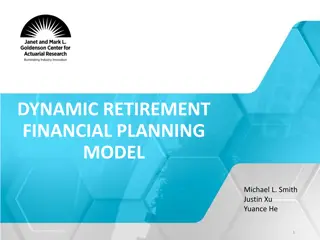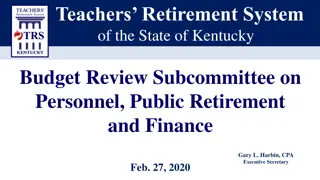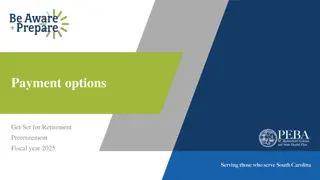Overview of Oklahoma Teachers Retirement System
Learn about the history, membership eligibility, appointing authority, actuarial and financial statistics of the Oklahoma Teachers Retirement System (OTRS). Discover details such as average salaries, years of service, benefits, funded ratio, unfunded liability, contributions, and expenditures for the fiscal year 2016.
Download Presentation

Please find below an Image/Link to download the presentation.
The content on the website is provided AS IS for your information and personal use only. It may not be sold, licensed, or shared on other websites without obtaining consent from the author.If you encounter any issues during the download, it is possible that the publisher has removed the file from their server.
You are allowed to download the files provided on this website for personal or commercial use, subject to the condition that they are used lawfully. All files are the property of their respective owners.
The content on the website is provided AS IS for your information and personal use only. It may not be sold, licensed, or shared on other websites without obtaining consent from the author.
E N D
Presentation Transcript
UCO Faculty February 16, 2017 Tom Spencer, Executive Director
History and Overview Created in 1943 by an act of the Oklahoma Legislature. Official operations began July 1, 1943. First retirement checks disbursed Jan. 1, 1947. Employees of more than 600 local school districts, career technology schools, public colleges and universities are enrolled as members of OTRS. 2
Appointing Authority & Qualification Name Governor, 4 Coterminous (Public or private funds management, banking, law or accounting experience) Governor (Higher Education Rep.) Governor (Nonclassified Personnel) Senate Pro Tempore (Active Classroom Teacher) Vacant Senate Pro Tempore (Retired Member) House Speaker (Active Classroom Teacher) House Speaker (Retired Member) Ex Officio - State Superintendent or designee Ex Officio - OMES Director or designee Ex Officio - Career-Tech Director or designee Nonvoting - statewide organization representing retired educators Dr. Gary Trennepohl, Chairman William L. Bill Peacher Roger Gaddis Kevin Moore Dr. Myron Pope Judy Harris, Board Secretary Vernon Florence, Vice Chairman Sharee Madsen Christa Hughes David Kinney, Designee Jill Geiger, Designee Dr. Greg Winters, Designee Elaine Dodd
OTRS Membership Available to all public school employees working half-time or more. Teachers and administrators are required to be members. Support staff may join voluntarily. As of June 30, 2016, TRS had 172,454 total members: 89,490 Active Members 60,261 Retired Members (incl. beneficiaries) 10,813 Inactive Vested Members 11,890 Inactive Non-vested Members 4
Member Overview (end of FY 2016) Average Active Member $47,188 Salary 45.8 Years of Age 11.0 Years of Service Average Retired Member $20,598 Annual Benefit (regular ret ees) $20,147 (reg. & disab. ret ees, benefic. & spouses) 5
Actuarial Statistics 2016 Funded Ratio 65.7% on actuarial basis (66.6% in FY 2015) 62.2% on a market value basis (69.6% in FY 2015) Funding Period 23 yr. s Mkt. Val; 20 yr. s actuarial (FY 2015) 14 yr. s Mkt.; 16 yr. s actuarial Actuarial Determined Contribution Rate (Employer) 17.1% of payroll (17.2% in FY 2015) *The TRS Board lowered its investment return assumption from 8.0% to 7.5% effective with the FY 2016 report 6
Actuarial & Financial Statistics 2016 Unfunded Liability $7.615 Billion ($6.921 Billion in FY 2015) FY-2016 Contributions - $1.019 Billion Member Contributions - $294.4 M Employer Contributions - $409.7 M State Contributions (& grant match) - $315.6 M FY-2016 Expenditures - $1.29 B Benefit Payments - $1.25 B Refunds - $36.1 M Administrative Expenses - $4.45 M 7
Funding Ratio Assets vs. Liabilities $25,000 70% 60% $20,000 50% $15,000 40% 30% $10,000 20% $5,000 10% $0 0% 1997 1998 1999 2000 2001 2002 2003 2004 2005 2006 2007 2008 2009 2010 2011 2012 2013 2014 2015 2016 Assets (Left) Liabilities (Left) Funded Ratio (Right) 8
Dedicated Revenue OTRS received a little more than $1 billion in income from all sources in FY 2016, not counting investment income. Member contributions were about $294.4 million Employer contributions and federal/grant matching contributions were about $435.5 million State dedicated revenue added another $289.8 million 9
Dedicated Revenue (contin.) What were the sources of State dedicated revenue? Personal and corporate income tax - $162 million ($175 million in FY 2015) Sales and use taxes - $123 million ($133 million in FY 2015 Lottery - $2.5 million ($2.7 million in FY 2015) Cigarette and tobacco products - $1.65 million ($1.6 million in FY 2015) Other - $2,663 ($4,500 in FY 2015) 10
OTRS Investment Performance Annual Market Rate of Return (Fiscal Year) 2016 (2.00)% 2015 3.5% 2014 22.4% 2013 17.8% 2012 1.80% 2011 23.5% 2010 16.6% 2009 (15.25)% 2008 (7.50)% 2007 18.00% 2006 9.40% 2005 10.00% 2004 20.2% 2003 4.80% 2002 (5.40)% 2001 (2.30)% 2000 10.5% 1999 11.9% Compound annualized rate of returns (end of fiscal years): 10 yr. 7.1% 5 yr. 10.3 % 3 yr. 7.5% 11
Investment Returns Historical Investment Returns by Fiscal Year 25% 20% 15% 10% 5% 0% -5% -10% 1996 1998 2000 2002 2004 2006 2008 2010 2012 2014 2016 12
Investments Positives in Recent TRS Performance* Earned 7.2% for last 10 years (2nd percentile) Earned 11.9% for last 5 years (2nd percentile) Earned 7.0% for last 3 years (14th percentile) * Pension Commission (NEPC) thru 9/30/16 Negatives for FY 2016* After several years of great earnings, MLPs down (21.7)% Other classes cool off. Int l equity (8.8)%; Mid-cap (8.4)% *The Bogdahn Group thru 6/30/16 13
Financial Overview Summary System underfunded status continues but is improving Funding period down to 20 years from infinity Long-term financial performance is very good. Recent performance (thru FY 16) was down with the rest of the market, but July 1, 2016 to Dec. 31, 2016 return was 6.24%. Contributions & Revenue are roughly equal to Actuarially Determined Contributions. End of Calendar 2016 the portfolio was $14.4 billion 14
A Better Bang for the Buck (Nat l Institute on Retirement Security) Academic Study by NIRS published in 2008 Co-authored by Beth Almeida and William B. Fornia Study of how Defined Benefit (pension) plans are actually more cost-effective than Defined Contribution (401 k type) plans. See: http://www.nirsonline.org/storage/nirs/documents/Ban g%20for%20the%20Buck%20Report.pdf 15
Why 'Father of the 401(k)' says he regrets pushing the retirement plan Ted Benna is known as the father of the 401(k). As a benefits consultant with the Johnson Companies, he pitched the idea of a tax deferred savings plan as a supplement to highly compensated executives. The 401K was never supposed to be a substitute for pensions. http://www.csmonitor.com/Business/2017/0104/Why- Father-of-the-401-k-says-he-regrets-pushing-the- retirement-plan 16
Legislative Issues 2017 Session HB 1162 (Rep. McDaniel)This bill is titled the Pension Protection Act. It raises the retirement age for members starting service on or after 11/1/2017 to 62 years of age with at least 30 years service and age 67 for those who have vested. Comment: Retirement ages were just increased in 2011. Before that the retirement age had not been changed since 1992. HB 1172 (Rep. McDaniel) The Retirement Freedom Act of 2017 establishes an optional DC plan for any employee otherwise eligible for membership in TRS on or after July 1, 2018. The minimum employee match is 4.5% with an employer match of 6%. Employees who put in 7% contribution will have their contribution matched by a 7% employer contribution. The plan is patterned after the OPERS mandatory DC plan using a 401(a) plan for the 4.5% minimum match and all employer contributions. Any employee contributions over 4.5% would be in a 457 plan. Comment: We think there is a fiscal impact from this bill. It may extend the number of years we predict to get to a 100% funded ratio. 17
Legislative Issues 2017 Session (contin.) HB 1339 (Rep. McDaniel) This is a TRS Request bill It permits TRS to terminate its 403(b) plan, and clarifies language where the word Board appears in several places and changes it to TRS or the System. It also clarifies those eligible for disability to those who cannot perform the job for which they are employed. Comments: Passed out of House committee on 2/14/17. HB 1340 (Rep. McDaniel) The committee substitute provides one- time stipends to retirees of most state retirement systems. The TRS stipend would be $750 since the TRS funded ratio is between 60% & 80%. It would be payable on October 1, 2018 to retirees who had been retired at least three (3) years. Comment: Better than a poke in the eye with a sharp stick. 18
Legislative Issues 2017 Session (contin.) HB 1796 (Rep. Echols) Amends OPLAAA to permit one- time stipends of 2% of a retiree s benefit if, after paying the stipend, the funded ratio of the system is not go below 90%. Comment: This bill would not help TRS retirees. The funded ratio is near 66% now and would be lower after a stipend. SB 242 (Sen. Pugh) This bill puts the State Treasurer on the boards of TRS and OPERS. Comment: Both boards seem to be functioning quite well. An odd number on a state board is generally not a great idea. 19
Legislative Issues 2017 Session (contin.) SB 491 (Sen. Standridge) This bill would amend OPLAA to permit COLAs and other benefit increases as long as the payment wouldn t lower the funded ratio of the plan below 80%. It also states that future benefit increases on or after July 1, 2017 shall be based on either the federal CPI-W or the system can approve future increases if a sensitivity analysis shows the system will be 100% funded within 40 years. This sensitivity analysis must be done every 5 years. Comment: Still no help to TRS retirees. A 40 year sensitivity analysis? SB 667 (Sen. Newberry) This bill expands the type of military service that can be purchased as credited service in TRS. Comment: All such service must be purchased at full actuarial cost. There is no real fiscal impact to this bill. 20
Tom Spencer, Executive Director Oklahoma Teachers Retirement System (405) 521-4745 (800) 543-6044 www.ok.gov/trs 21
